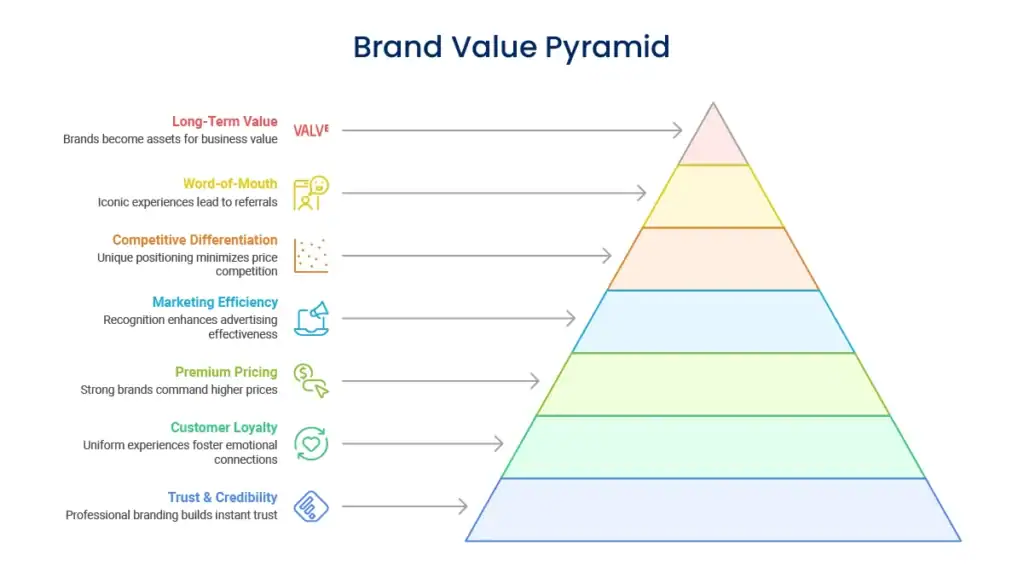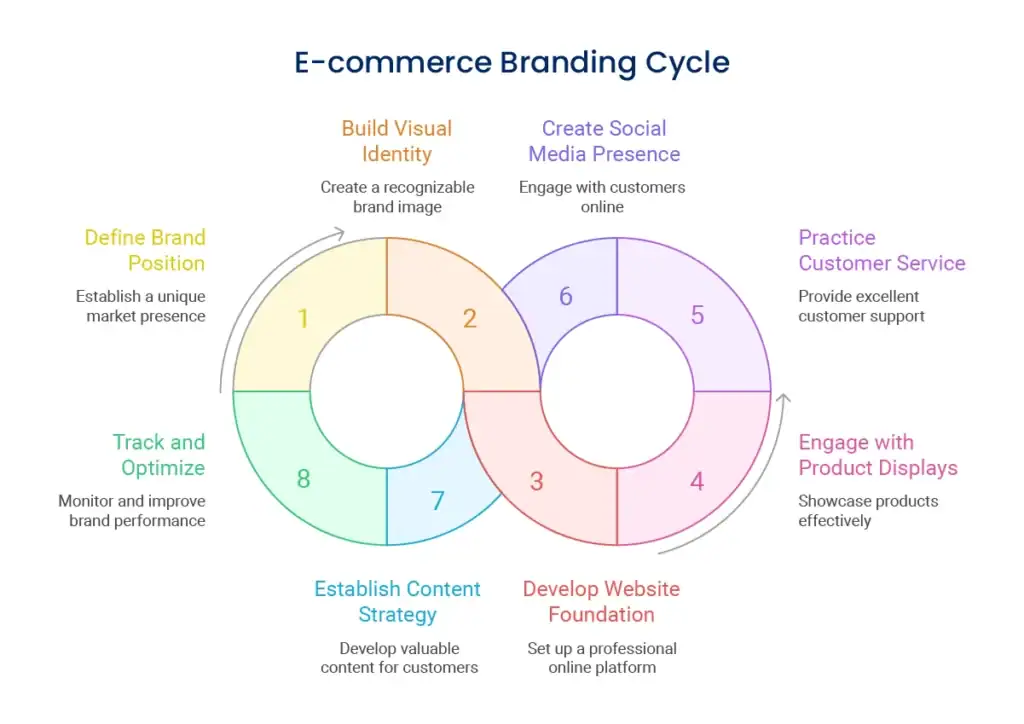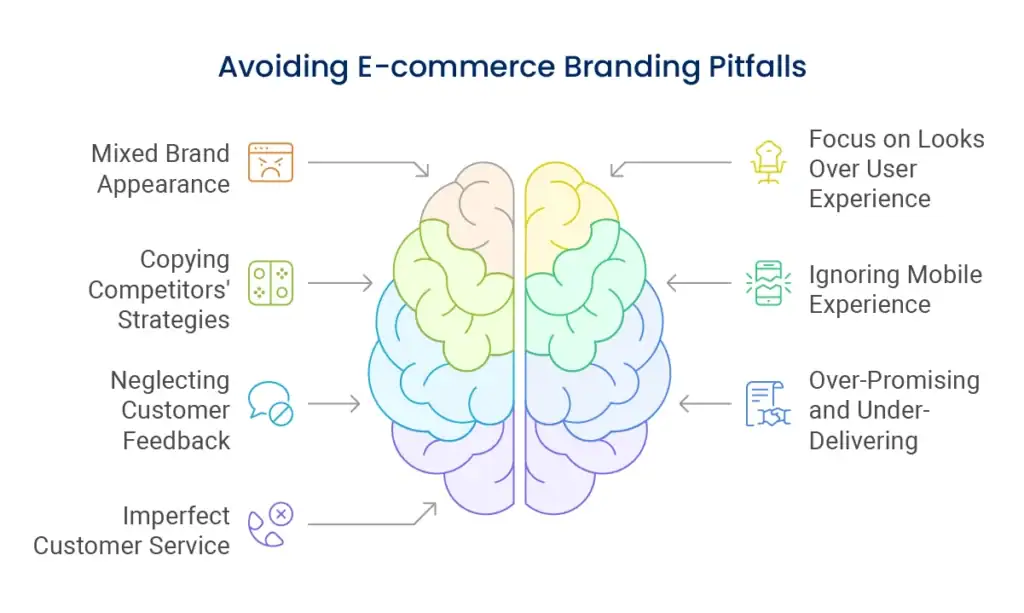Custom Design
Imagine this: A potential buyer visits your online shop for the first time. In a matter of seconds, they’re judging your credibility, quality, and trustworthiness. E-commerce branding is not simply about having a pretty logo or pretty colours – it’s about making that instant connection that turns browsers into buyers and one-time buyers into loyal champions.
Your own e-commerce site competes with aggressive rivalry every day. With infinite possibilities at the customers’ fingertips, they require strong reasons to prefer your brand over others. Effective e-commerce branding creates the digital trust that fosters customer loyalty and has a direct bearing on your sales numbers.
This material delves into how to create a strong e-commerce brand that speaks to your audience, builds trust, and forms long-term customer relationships that drive business success.

E-commerce branding is the overall digital identity of your online company. It involves all points at which customers are coming into contact with your brand – from the design of your website and product descriptions to your social media footprint and customer support strategy.
Unlike retail brand building, e-commerce brand building only happens online where customers can’t touch or engage in a face-to-face manner with the staff. Therefore, there are special challenges that demand special strategies to win trust and engagement.
Your e-commerce brand is the bridge between your products and customers’ hearts. It speaks volumes about your values, quality expectations, and trustworthiness through visual cues, message, and experience. Done well, it turns your online store from an ordinary sales platform into a destination of trust that customers revisit again and again.
The strength of e-commerce branding is that it can make your business stand out in busy markets. It makes it easy to help customers know why they need to buy your products instead of competing ones, building perceived value that can justify charging more.

Powerful e-commerce branding generates quantifiable business outcomes that have a direct effect on your bottom line. Here’s how investing in your digital brand identity becomes critical to your long-term growth:

Professional branding conveys dependability to new arrivals, lowering bounce rates and boosting conversion rates
Uniform brand experiences develop emotional connections that drive repeat buys and higher order values
E-commerce websites with strong brands can command 10-20% higher prices than commodity competitors for commoditized products
Brand recognition enhances the effectiveness of advertising and decreases customer acquisition costs
Differentiated brand positioning enables you to differentiate yourself in competitive marketplaces and minimize price-based competition
Iconic brand experiences lead to customers referring your store to relatives and friends
Small online businesses tend to downplay branding’s influence on sales performance. But brands that invest in professional, consistent presentation generally have 20-30% higher conversion rates than companies with poor or inconsistent branding.
Trust is the building block of successful e-commerce business relationships. Since there is no physical contact, customers are completely dependent on digital cues to gauge your credibility and professionalism.
Your digital trust architecture consists of security badges, customer reviews, professional photography, transparent return policies, and prompt customer service. All these factors combine to instill confidence in visitors that your business is legitimate and concerned with customer satisfaction.
Establishing that trust takes attention to little details that promise professionalism. Good product photography, well-written descriptions, simple navigation, and speedy loading times all generate a sense of reliability.
Your e-commerce brand experience goes far beyond visual design. It covers all the interactions that your customers have with your business, from discovery right on through to post-purchase support.
Customer journey mapping identifies important moments at which branding can impact the buying decision. The touchpoints are email communications, checkout procedures, package design, and follow-up service interactions.
Optimizing these experiences guarantees consistency of brand message throughout the full customer lifecycle, reinforcing your value proposition at key decision moments.
Visual consistency on all digital channels builds professional credibility and brand recognition. Your color scheme, font style, imagery, and logo use need to stay the same whether customers engage with your brand on your website, social media, or email campaigns.
Strong visual identity carries over into product photography, where they are frequently the key influence in decision to purchase. Professional, regular photography that presents your brand personality enables customers to visualise products and gain assurance in quality.
Excellent design involves user interface choices that ease shopping and make it enjoyable. Simple layouts, intuitive navigation, and mobile-responsiveness are all part of good brand perception.
Your brand narrative sets your company apart from others selling the same kind of product. Great content strategy interweaves this story across product descriptions, about pages, blog posts, and marketing copy.
E-commerce storytelling extends beyond the history of your company. It encompasses customer testimonials, behind-the-scenes stories, and value-based messaging that speaks to your target market’s desires and pain points.
Content strategy also includes SEO aspects that allow customers to find your brand naturally. Properly-optimised content that has real value increases authority and trust and enhances search visibility.
Customer reviews, testimonials, user-generated content, and social media followers are strong trust indicators for e-commerce brands. These assets present third-party assurances of your assertions regarding quality and service.
Having strong review systems, including customer images, and displaying social media mentions generates real credibility that drives purchasing behaviors. Studies indicate 90% of shoppers read reviews when they make a purchase online. Creating credibility systems involves continuous effort in ensuring customer satisfaction is encouraged to voice their experience while deflecting negative feedback promptly and professionally.


Begin by defining your target market, unique value proposition, and competitive positioning. Learn about your ideal customers’ demographics, interests, pain points, and shopping habits.
Create a brand positioning statement that clearly says why customers will select your products from others. This statement should support specific benefits and values that appeal to your target market.
Develop sophisticated buyer personas that inform all branding choices. Knowing what drives, worries, and delights your customers ensures that your brand message resonates truly.
Design an in-depth visual identity that encompasses logo options, color schemes, typeface choices, and imagery standards. Make sure everything interacts beautifully across various digital channels and screen sizes.
Create templates for major brand touchpoints such as website headers, email signatures, social media postings, and packaging designs. Repetitive use of visual elements creates recognition and professionalism.
Think about how your visual identity works on mobile devices, where most of your customers will first find out about your brand. Mobile-optimised design is not a choice – it’s a requirement for today’s e-commerce branding success.
Your website is your main brand headquarters. Invest in expert design that echoes your brand personality while focusing on user experience and conversion optimisation.
Use clear navigation hierarchies that make it easy for customers to locate products. Add important trust signals such as security badges, contact details, return policies, and customer service options prominently.
Ensure quick loading times and mobile-friendliness. Technical performance has a direct effect on brand perception – slow sites imply amateurish operations and enrage potential buyers.
Establish consistent product photography guidelines that present items in an appealing manner without misrepresenting quality or features. Professional photos have a high influence on conversion rates and return rates.
Develop product descriptions which balance useful facts with the personality of the brand. Speak in a voice that resonates with your target market and includes all information required for intelligent buying decisions.
Produce product videos, 360-degree images, or interactive elements that assist customers in getting products better understood without hands-on investigation. Rich media instills confidence and eliminates purchase uncertainty.
Set customer service standards that embody your brand values. Train support members of staff to speak in ways that reinforce your brand personality while effectively resolving problems.
Create several support channels that align with customer behavior. Options may range from live chat, email support, phone support, and social media response systems.
Create service recovery processes that convert negative experiences into positive brand impressions. The manner in which you respond to problems is sometimes more important than never having problems.
Create consistent brand presence on social media sites where your target customers are active. Identify sites that are in line with your target audience demographics and shopping habits.
Develop content calendars that interchange promotion messages with useful, interest-stirring content building community around your brand. Social media exists brand building as well as direct sales to your benefit.
Interact genuinely with fans, message and comment back on time, and leverage social media to reveal brand character outside of product promotion.
Produce useful content that makes your brand an authority in the industry and assists customers in making educated buying choices. This can include shopping guides, fashion inspiration, or tutorial articles.
Optimise for search engines to enhance organic visibility and drive prospective customers browsing products within your category. Quality content creates trust as it drives traffic.
Create email sequences that cultivate customer relationships over time. Consistent, valuable contact keeps your brand in mind between purchases.
Set key performance indicators that track brand health such as customer satisfaction scores, repeat purchase rates, average order values, and brand mention sentiment.
Gather customer feedback on a regular basis using surveys, reviews, and direct interactions. Apply insights to enhance brand strategy and continuously improve customer experiences.
Track online mentions of your brand and reviews on different platforms. Answer feedback professionally and address concerns in a timely manner to ensure positive brand reputation.

Current e-commerce branding demands efficient integration among different technology tools and platforms. How effectively different systems integrate with each other to produce efficient customer journeys is largely what your brand experience relies on.
Select e-commerce platforms that accommodate your branding needs while allowing room for expansion. Take into consideration customisation opportunities, loading speeds, mobile responsiveness, and the capability to integrate with marketing software.
Use customer relationship management systems that assist in personalising brand interactions by applying purchase history, preferences, and behaviour patterns. Personalised experiences enhance brand relationships and build customer loyalty.
Consider using chatbots or AI customer service solutions that ensure brand voice while offering immediate assistance. These solutions must be used to supplement, not substitute, human contact for issues that are more complex.
Integration includes payment processing, shipping status notifications, and follow-up communications after the sale. All automated messages must be both your brand personality and intended to have positive associations.

Effective e-commerce branding involves constant measurement and optimisation through data-driven insights. Measuring the right things shows you what is working and what can be improved.
Track conversion rates from various sources of traffic to see which touchpoints for a brand are best at driving sales. This information optimises spend on marketing and prioritises brand messaging.
Monitor repeat purchase rate and customer lifetime value as measures of the strength of brand loyalty. Strong brands usually experience high retention levels and growing expenditure over time.
Examine customer comments themes to spot brand perception differences between your plans and customer reality. Routine perception audits ensure brand relevance and authenticity.
Utilize heat mapping tools and user behavior analytics to comprehend how your customers are engaging with your website. This information provides insight into areas of opportunity to enhance brand presentation and enhance user experience.
Track social media engagement levels and sentiment analysis related to brand mentions. Social media offers real-time feedback regarding brand perception as well as the level of customer satisfaction.

Reputation issues such as negative reviews, social media criticism, supply chain issues, and security threats confront e-commerce brands. Anticipating such risks safeguards long-term brand value.
Establish crisis communication plans that delineate response processes for various situations. Prompt, professional responses frequently stop tiny problems from growing into full-blown brand harm.
Establish review management processes that foster positive feedback and constructively address complaints. Professional replies to criticism express concern for customer satisfaction.
Enact security practices that safeguard customer information and disclose these protections openly. Security intrusions can ruin e-commerce brand confidence, so prevention is vital.
Track brands are mentioned all over the net to catch problems before they become out of control. Early response generally keeps bad publicity from gaining traction and becoming damage that lasts.
Create good brand value consistently so that the occasional bad thing doesn’t unfairly skew the overall impression. Power brands bounce back faster than weak ones do.

Creating sustainable e-commerce brand equity takes steady effort over time. Short-term strategies may generate near-term sales, but sustained success depends on delivering real value to customers.
Concentrate on delivering outstanding product quality and customer service that surprises and delights. Positive experiences establish emotional ties that move beyond price competition.
Create brand partnerships and collaborations that support your positioning and build new audiences. Strategic partnerships can build credibility and extend market reach.
Think about creating unique products or services that customers can’t get anywhere else. Special products or services provide strong motives for customers to pick your brand over others.
Invest in building a community around your brand on social media sites, email lists, or loyalty programs. Active communities offer insightful feedback while producing word-of-mouth marketing.
Develop sustainability principles and social responsibility programs that are consistent with customer values. Contemporary consumers are more likely to pick a brand they share personal values and beliefs with.

As your e-business matures, more sophisticated strategies can further differentiate your company and reinforce customer ties. They demand more advanced planning and implementation but yield strong competitive benefits.
Use personalisation tools that generate customized shopping experiences from the customer’s behavior, tastes, and purchase history. Advanced personalisation can raise conversion rates 10-15%.
Build subscription or membership programs that establish long-term relationships with customers. These programs drive customer lifetime value and generate recurring revenue streams.
Explore growth in new markets or product categories that build on your brand equity. Brand extensions can fuel growth when they match customer expectations and brand positioning.
Investigate augmented reality or virtual reality technologies for improving product visualisation and building memorable brand experiences. These technologies can increasingly be accessed and can go a long way towards differentiating your brand.
Collaborate with influencers and content creators who resonate sincerely with your brand values and target audience. Genuine collaborations offer credible third-party endorsement along with reaching engaged audiences.
The digital environment keeps changing at a fast pace, and e-commerce brands need to remain flexible while holding onto constant core identity. Future-proofing your brand guarantees long-term success and relevance.
Keep abreast of new technologies, platform developments, and trends in consumer behavior that could affect your business. Adoption of the appropriate innovations early on can yield benefits in competitiveness.
Develop adaptable brand guidelines that permit evolution without compromising recognizable core elements. Your brand must remain fresh and contemporary without compromising built equity and recognition.
Invest in customer data analysis tools that offer more insights into evolving preferences and behavior. Knowing your customers better enables you to foresee their needs and preferences.
Build omnichannel competencies that produce seamless experiences across every touchpoint where customers meet your brand. Today’s consumers demand consistent experience no matter how they engage with your firm.
Consider environmental and social impact factors that increasingly influence customer choices. Sustainable brand practices can differentiate your business while attracting conscious consumers.

Most companies fall into repetitive mistakes that weaken their e-commerce brand building. Steering clear of these will make your brand more effective and well-received by customers.
Learning from such typical blunders prevents you from making costly branding faux pas that take months or years to recover from.

Knowledge of return on investment from brand efforts makes it easier to continue investing and maximize strategies for improved performance. Although branding influence can be difficult to measure directly, there are various metrics that reflect the strength and performance of your brand.
Monitor brand awareness metrics via surveys, direct traffic increases, and branded search volume gains. These metrics reflect how effectively your branding efforts are creating recognition and recall.
Track customer acquisition cost by channel to identify the brand touchpoints that attract new customers most efficiently. Good brands generally have lower acquisition costs over the long term.
Track pricing power by experimenting with small price rises and the reaction of customers. Good brands are usually able to sustain customer loyalty in the face of moderate price rises.
Compare the customer lifetime values by different acquisition periods to find out how brand improvements affect long-term customer relationships and profitability.
Monitor brand sentiment using social media monitoring, review analysis, and customer feedback surveys. Positive sentiment trends signify effective brand building campaigns.
Various e-commerce industries necessitate customized branding strategies that meet specific customer expectations, regulatory demands, and competitive forces. An understanding of your industry’s relative strengths and weaknesses optimises branding strategy.
Fashion and lifestyle brands tend to focus on visual narrative, influencer collaborations, and seasonal content strategies. The brands require intense social media presence and trend-sensitive messaging.
Technology and electronics brands generally tend to emphasize product features, innovation communication, and technical authority. These types of brands gain the most from in-depth content marketing and subject expertise positioning.
Health and wellness brands need specific emphasis on credibility, compliance with regulatory issues, and trust establishment. Customer endorsements and professional approvals are particularly well-suited in these categories.
B2B e-commerce brands require different strategies that focus on efficiency, dependability, and business value over emotional connection. Case histories and ROI presentations are most effective.
Take healthcare branding strategies, for instance, that target particular regulatory needs and patient privacy issues while establishing trust and credibility.

Effective e-commerce branding calls for well-trained team members who are aware of both digital marketing fundamentals and brand management best practices. Developing internal capabilities ensures sustained brand performance through all activities.
Train customer service reps to represent your brand personality in every customer engagement. These representatives typically reflect your brand more explicitly than any advertising materials.
Create content creation abilities that can create uniform, high-quality material in various formats and media. Great content teams know brand voice and are able to tailor messaging for various audiences.
Create analytics abilities that can decode brand performance statistics and turn insight into actionable change. Data-driven brand management outperforms intuition-driven techniques.
Consider hiring professional branding services where internal expertise is not available to handle specialized projects or where outside perspective is necessary and brings real benefits.
Invest in regular training and development in order to keep staff up-to-date with changing best practices, platform updates, and industry trends that affect the effectiveness of the brand.
E-commerce branding is most effective when combined smoothly with overall marketing initiatives instead of being a standalone exercise. Integrated methods maximize the effect of single tactics.
Align brand positioning with pricing strategies, product choices, and target market selection. Inconsistency between these factors confuses customers and reduces overall effectiveness.
Coordinate brand messages with content marketing strategies that appeal to SEO objectives while maintaining brand personality and value proposition.
Sync social media branding with paid advertising campaigns branding to make organic and paid touchpoints consistent.
Embed email marketing programmes with overall brand messaging while tailoring content to vary by customer segments and lifecycle stages.
Determine whether performance monitoring systems can capture both brand health metrics and direct marketing performance to see total programme effectiveness.
Establishing meaningful brand recognition usually takes 6-12 months of sustained effort, although early gains in customer perception may be achieved in weeks after introducing professional branding elements. The duration would vary based on marketing expense, target market size, competitive rivalry, and quality of execution.
Successful brands need continuous investment and upgrading as opposed to single projects. Although visual identity components can be applied swiftly, creating real customer trust and loyalty builds up over time through repeated positive experiences.
Successful e-commerce branding can start with budgets as little as ₹50,000-₹1,00,000 for simple visual identity development and website optimization. But frequent branding interventions usually call for monthly spending of ₹25,000-₹75,000 on content generation, social media management, and performance tracking.
Budget levels increase with business size and ambition. Larger companies with high growth aspirations could spend ₹2,00,000-₹5,00,000 a month on large-scale branding initiatives encompassing advertising, content marketing, and sophisticated analytics.
The secret is beginning with core elements and opening up investment as you recognize encouraging returns from early branding initiatives.
Monitor several metrics such as conversion rate gain, customer lifetime value growth, repeat purchase rates, brand mention sentiment, and direct traffic growth. Gains in these metrics equate to improved brand performance.
Customer survey feedback, review ratings, and social media activity give qualitative data regarding brand perception evolution over time. Trends can be kept under constant monitoring to see what’s succeeding and where changes are required.
Attribute tracking that relates branding touchpoints to sales results can be implemented, although this entails advanced analytics capability and is likely to miss some of the branding influence.
Branding in e-commerce is one of your strongest weapons for creating durable competitive edge and customer loyalty. Successful branding initiatives establish emotional bonds superior to price competition and achieve quantifiable gains in sales performance and customer retention.
The cost of professional e-commerce branding invests in dividends in the form of lower customer acquisition costs, higher average order values, and better customer lifetime values. Over time, these rewards build into valuable business assets that translate to long-term profitability and growth.
Achievement demands repeated effort, customer-centric thinking, and a readiness to modify as a result of performance statistics and market feedback. The companies that establish powerful e-commerce brands now will have enormous competitive advantages as digital commerce keeps on increasing and expanding.
Creating successful e-commerce brands takes specific skill sets in digital marketing, user experience design, and brand strategy. When you’re ready to build your online shop into a respected, profitable brand that customers adore, our crew of experts can assist you with creating and executing integrated branding solutions for your particular market and goals.
From the development of visual identity to sophisticated customer journey optimization, we offer the strategic insight and implementation assistance necessary to develop enduring e-commerce brand equity that fuels long-term business growth.

Enter your email to get instant access